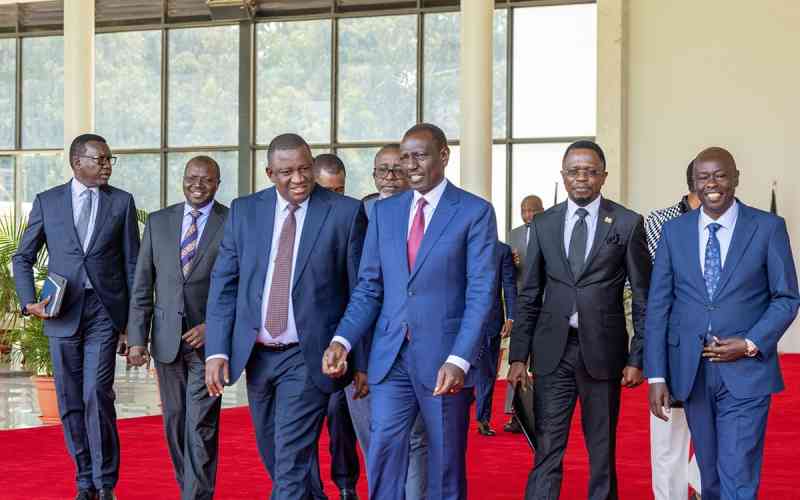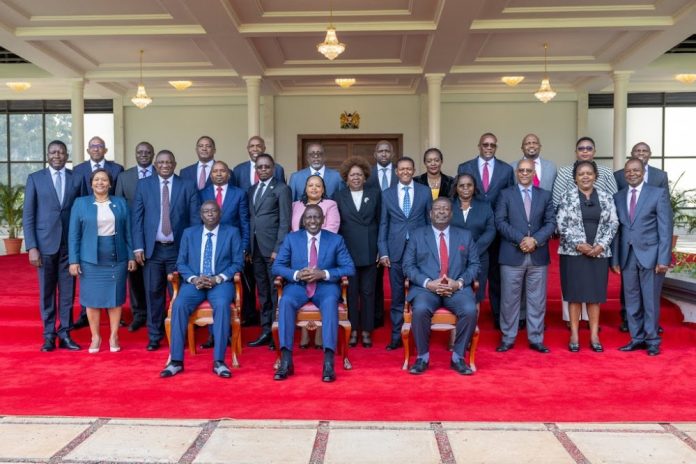Facebook Twitter (X) Instagram
President William Ruto’s decision to dissolve his Cabinet in Kenya follows a pattern of historical precedents and constitutional procedures aimed at reshaping executive governance in response to national challenges and political dynamics. This action, reminiscent of late President Mwai Kibaki’s decisions during his tenure, reflecting the flexibility and authority vested in the presidency under Kenya’s constitutional framework.
Historical Context of President Ruto’s Cabinet Dissolution and Similarities with Kibaki’s Actions
President Ruto’s decision to dissolve his Cabinet today mirrors actions taken by President Kibaki in the past. Notably, Kibaki suspended parliament and dismissed his Cabinet following a significant defeat in a constitutional referendum, interpreted as a vote of no confidence in his administration.
Similarly, President Ruto’s dissolution was influenced by public protests and demands for reform, citing concerns over the incompetence and integrity issues of several Cabinet Secretaries allegedly involved in corruption scandals. These parallel underscores the constitutional prerogative of the President to reorganize the executive branch in response to evolving political and governance challenges.
Constitutional Basis and Authority
The authority for the President to dissolve the Cabinet in Kenya is explicitly outlined in Article 152 of the Constitution. This provision grants the President discretionary power to dismiss individual Cabinet Secretaries or dissolve the entire Cabinet. Such decisions are typically made in consideration of political dynamics, governance issues, or the need to rejuvenate government operations. The constitutional framework ensures that executive actions are anchored in legal principles and institutional safeguards, maintaining stability and accountability within the government.
Immediate Effects of President Ruto’s Cabinet Dissolution
When the President dissolves the Cabinet, all Cabinet Secretaries cease their functions immediately. This action does not equate to their resignation but constitutes a removal from office by the President’s directive. Only specific officials, such as the Deputy President and others expressly exempted, continue in their roles to ensure continuity in executive leadership during the transitional phase.

Appointment and Nomination Process
Following Cabinet dissolution, the President is constitutionally mandated to nominate new Cabinet Secretaries to head various ministries. This nomination process is pivotal in reshaping the executive branch to align with the President’s policy priorities and strategic objectives. Considerations such as expertise, competence, regional balance, and inclusivity guide the selection of Cabinet members, ensuring a diverse and capable leadership team.
Parliamentary Vetting and Approval
Nominated Cabinet Secretaries undergo rigorous vetting by relevant parliamentary committees. These committees scrutinize the nominees’ qualifications, integrity, and readiness to hold office, serving as a crucial mechanism for parliamentary oversight. The vetting process ensures that only individuals deemed suitable and competent assume leadership roles within the government, reinforcing principles of accountability and transparency.
Confirmation and Appointment
Upon successful completion of the vetting process, nominees are presented to the National Assembly for approval. The Assembly conducts a thorough debate and votes on each nominee individually, requiring a simple majority for approval. Once confirmed by Parliament, the President formally appoints and swears in the new Cabinet Secretaries. They subsequently assume office and commence their official duties, responsible for implementing government policies and managing public resources in collaboration with other governmental bodies.
Resumption of Government Functions
With the appointment of new Cabinet Secretaries, government ministries and departments resume their operational functions. Cabinet Secretaries play a pivotal role in overseeing the delivery of public services, advancing national development agendas, and addressing pressing societal issues. Their collective efforts contribute to maintaining effective governance and meeting the expectations of the Kenyan people.
Governance and Accountability
The dissolution and reconstitution of the Cabinet underscore Kenya’s commitment to democratic governance, institutional resilience, and responsiveness to public expectations. This process emphasizes accountability, transparency, and efficiency within the executive branch, holding government officials accountable to high standards of performance and conduct. It reinforces the rule of law and enhances public confidence in the government’s capacity to fulfill its mandate and serve the interests of the nation.
Conclusion
In conclusion, President Ruto’s decision to dissolve his Cabinet marks a pivotal moment in Kenya’s governance framework. It initiates a structured process of transition, reorganization, and renewal within the executive branch, aimed at enhancing governmental effectiveness and responsiveness to contemporary challenges. Through constitutional provisions, parliamentary oversight, and public scrutiny, Kenya upholds principles of democratic governance and institutional stability in managing executive leadership transitions. This constitutional process not only reaffirms the rule of law but also strengthens public trust in the government’s ability to deliver on its promises and uphold the aspirations of the Kenyan people.

